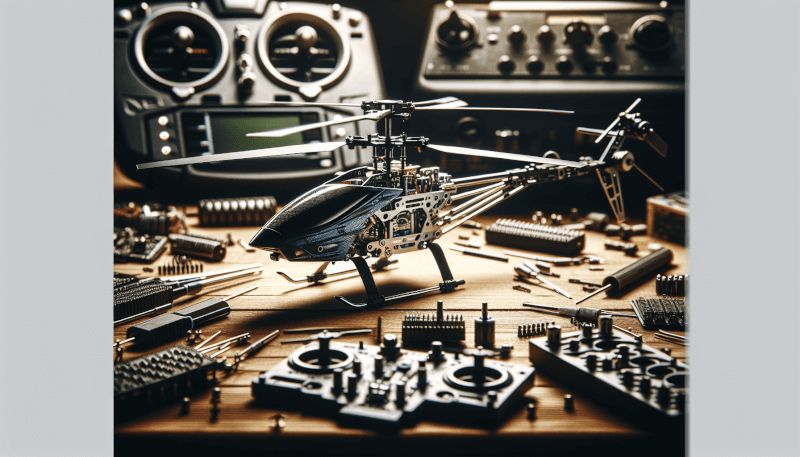Are you an RC helicopter enthusiast looking to take your hobby to the next level? Well, look no further! This article is your ultimate guide to the best DIY RC helicopter projects. Whether you’re a seasoned pro or just starting out, we’ve got something for everyone. From building your own custom-designed helicopter from scratch to modifying existing models for enhanced performance, these projects will surely ignite your passion for remote-controlled flying. So, grab your tools and get ready to embark on an exciting journey of building and flying your very own RC helicopters!
Introduction
Overview of DIY RC helicopter projects
DIY RC helicopter projects are a fantastic way for enthusiasts to dive into the world of remote-controlled helicopters. These projects allow you to explore your creativity, hands-on skills, and technical knowledge while building a personalized helicopter from scratch. With various types of DIY RC helicopters available, you can choose the one that aligns with your interests and skill level, whether it be Arduino-based, 3D printed, FPV, gasoline-powered, customized scale model, collective pitch, turbine-powered, autonomous, or micro RC helicopters.
Benefits of DIY projects for enthusiasts
Engaging in DIY projects offers a plethora of benefits for RC helicopter enthusiasts. Firstly, it allows you to have full control over the design and customization of your helicopter. From choosing components and materials to modifying features and paint schemes, you can create a unique and personalized flying machine that reflects your style and preferences.
Additionally, DIY projects provide a valuable learning experience. As you build and assemble the helicopter, you will gain a deeper understanding of how the various components work together to achieve flight. This knowledge can be applied to troubleshooting and maintenance in the future, allowing you to become a more skilled and knowledgeable RC helicopter pilot.
Moreover, DIY projects foster a sense of accomplishment and satisfaction. Completing a project from start to finish, especially one as complex as building an RC helicopter, can boost your confidence and provide a great sense of achievement. The joy of seeing your creation take flight is unparalleled and can ignite a lifelong passion for RC helicopters.
Now, let’s explore some of the exciting DIY RC helicopter projects that you can embark on!

1. Arduino-based RC Helicopter
Overview of Arduino-based RC helicopter projects
Arduino-based RC helicopter projects combine the convenience of Arduino microcontrollers with the thrill of piloting a helicopter. These projects allow you to build a customized helicopter from scratch, incorporating Arduino boards for flight controls and stabilization.
Building an Arduino-based RC helicopter from scratch
To embark on an Arduino-based RC helicopter project, you’ll need to gather the necessary components, including an Arduino board, brushless motors, ESCs (Electronic Speed Controllers), gyro sensors, and a receiver. Assemble the frame and mount the motors, ESCs, and gyro sensors securely. Connect these components to the Arduino board according to the specific wiring diagram provided by the project you’re following.
Programming the flight controls and stabilization
Once the hardware is in place, the next step is programming the flight controls and stabilization. Utilizing Arduino’s programming language, you’ll write code that reads input from the RC receiver, translates it into appropriate motor speeds, and ensures the helicopter remains stable during flight. It’s important to fine-tune the PID (Proportional, Integral, and Derivative) parameters to achieve optimal control and stability.
Adding features like autonomous flight and telemetry
With an Arduino-based RC helicopter, you have the flexibility to add additional features like autonomous flight and telemetry. By integrating GPS modules and implementing waypoint navigation algorithms, you can enable your helicopter to fly pre-determined routes autonomously. Additionally, telemetry systems can be incorporated to monitor the helicopter’s data in real-time, providing valuable information about altitude, battery voltage, and more.
Tips and tricks for successful Arduino-based projects
When undertaking an Arduino-based RC helicopter project, it’s essential to take a systematic approach. Ensure all components are securely mounted and connected, and carefully follow instructions and wiring diagrams. Conduct thorough flight testing, making small adjustments to the code and PID parameters as needed. Additionally, consider incorporating safety features such as fail-safe mechanisms to prevent accidents.

2. 3D Printed RC Helicopter
Overview of 3D printed RC helicopter projects
3D printing technology has revolutionized the world of RC helicopters, allowing enthusiasts to create intricate and lightweight parts with ease. 3D printed RC helicopter projects offer the opportunity to customize every aspect of your helicopter, from the frame to smaller components.
Choosing the right 3D printer and materials
Before diving into a 3D printed RC helicopter project, it’s important to select the right 3D printer and materials. Consider factors such as print quality, build volume, and durability. PLA (Polylactic Acid) and ABS (Acrylonitrile Butadiene Styrene) are commonly used materials for 3D printed RC helicopter parts due to their lightweight and robust properties.
Downloading and customizing 3D printable helicopter designs
Numerous online repositories, such as Thingiverse, offer a vast collection of 3D printable helicopter designs. Browse through these platforms to find a design that suits your preferences and skill level. Once you’ve selected a design, you can also customize it to add your personal touch. Alter the size, shape, or features to create a truly unique helicopter.
Assembling the 3D printed parts and components
With the 3D printed parts at hand, assemble them according to the provided instructions. Use adhesive or screws to secure components together firmly. It’s crucial to ensure that all parts fit together seamlessly and the frame is structurally sound. Take your time during assembly to avoid any mishaps.
Calibrating and testing the flight performance
After assembling the 3D printed RC helicopter, it’s time to calibrate and test its flight performance. Check the center of gravity and make any necessary adjustments to ensure it is properly balanced. Take the helicopter to an open area and conduct test flights, gradually increasing the throttle and assessing stability and control. Fine-tuning of the flight characteristics may be required to achieve optimal performance.
Enhancements and modifications for advanced users
For those looking to take their 3D printed RC helicopter to the next level, there are various enhancements and modifications that can be implemented. These include installing more powerful motors, upgrading the flight controller, or incorporating additional features like FPV systems or LED lights. Advanced users can experiment with different printing materials to further enhance the helicopter’s durability or aesthetics.

3. FPV (First Person View) RC Helicopter
Overview of FPV RC helicopter projects
FPV RC helicopter projects offer an immersive flying experience, allowing pilots to see and control their helicopters from a first-person perspective. By utilizing FPV systems and cameras, enthusiasts can get a bird’s-eye view of their aircraft, enhancing flight precision and enjoyment.
Selecting the appropriate FPV system and camera
Choosing the right FPV system and camera is essential for a successful FPV RC helicopter project. Consider factors such as video transmission range, image quality, and latency. Look for FPV systems specifically designed for RC aircraft and select a camera with high resolution to capture clear and detailed footage.
Installing and configuring FPV equipment on the helicopter
Once you have acquired the FPV system and camera, it’s time to install and configure them on the helicopter. Securely mount the camera to capture stable footage and ensure a clear line of sight. Attach the video transmitter and receiver to the helicopter and configure their frequencies and channels to avoid interference.
Setting up a video transmitter and receiver system
To establish a reliable video transmission, it is important to correctly set up the video transmitter and receiver system. Ensure the antennas are properly positioned to maximize signal strength and minimize interference. Conduct range tests to determine any potential dead zones and adjust the system accordingly for optimal performance.
Flying the RC helicopter using FPV goggles or monitor
With the FPV system properly installed and configured, it’s time to fly the RC helicopter using FPV goggles or a monitor. Put on the FPV goggles or mount the monitor and immerse yourself in the aerial view. Familiarize yourself with controlling the helicopter solely through the FPV feed, as it may require some adjustment if you are accustomed to line-of-sight flying.
Best practices for FPV flights and safety considerations
When engaging in FPV flights, safety should always be a top priority. Fly in approved areas away from prohibited zones or airports. Maintain a visual line of sight with the RC helicopter at all times and be aware of your surroundings. Start with short flights and gradually increase the flying time as you become more comfortable with the FPV experience. Always respect local regulations and operate within designated altitudes and airspace limitations.
Stay tuned for the next sections of this article, where we will explore even more exciting DIY RC helicopter projects!



